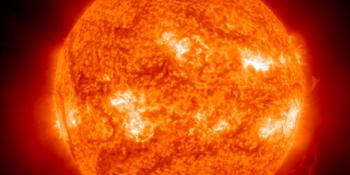Visualizzazione archivio di martedì, 6 novembre AM
Rapporto attività solare
Ogni brillamento solare menzionato nel rapporto ha un fattore di scala, applicato dal Centro di Predizione Meteorologica Spaziale (SWPC). A causa del fattore di scala del SWPC, i brillamenti solari sono segnalati come ridotti del 42%, rispetto ai dati di qualità scientifica. Il fattore di scala è stato rimosso dai nostri dati archiviati sui brillamenti solari, per riflettere le unità fisiche reali.
Rapporto dell'Attività Geofisica Solare 2001 Nov 06 2200 UTCPreparati dal SWPC della NOAA© ed elaborati da SpaceWeatherLive.com
Rapporto Congiunto USAF/NOAA dell'Attività Solare e Geofisica
SDF Numero 310 Emesso alle 2200Z il Nov 06 2001IA. Analisi delle Regioni Solari Attive e Attività dalle 2100Z-05 alle 2100Z-06 Solar activity was at moderate levels. Four M-class
events were reported during the period. Region 9687 (S20E08)
produced the largest event, an M2/1b flare at 06/0300 UTC. This
event also had an accompanying Type II radio sweep (velocity
estimated at 600 km/s). Region 9687 developed into a complex
beta-gamma-delta magnetic classification during the period. Region
9690 was by far, the most active region on the disk today. It
produced several C-class events and two minor M-class events. Region
9690 has fully rotated onto the disk and appears to be a moderately
large region (750 millionths) with a beta-gamma magnetic
classification. Region 9684 (N06W55), which produced the X1/3b
proton flare on 04 November, retains a beta-gamma-delta magnetic
classification, but did not produce any significant activity during
the period.
IB. Previsione dell'Attività Solare
Solar activity is expected to continue
to be moderate to high. Regions 9684, 9687, and 9690 all possess
major flare potential.
IIA. Sommario dell'Attività Geofisica dalle 2100Z-05 alle 2100Z-06
The geomagnetic field was at unsettled to severe storm conditions.
The full-halo coronal mass ejection (CME) from the 04 November event
impacted the geomagnetic field at 06/0150 UTC. This was indicated by
a 90 nT sudden impulse as measured by the USGS Boulder magnetometer.
Severe geomagnetic storming occurred between 06/0000 and 06/0600 UTC
and 15-1800 UTC. The greater than 10 MeV proton event peaked at
31,700 pfu at 06/0215 UTC. The greater than 100 MeV proton event
peaked at 253 pfu at 06/0220 UTC. Both proton events levels declined
sharply during the period but continued through the end of the day.
A polar cap absorption event remained in effect.
IIB. Previsione dell'Attività Geofisica
The geomagnetic field is
expected to be unsettled to minor storm conditions on the first day
of the period and then declining to mostly quiet to unsettled, with
isolated active conditions possible, on days two and three. However,
there have been several long and near long duration flares in the
last two days that could have produced earth-directed coronal mass
ejections. Since the onset of the proton storm at approximately 1700
UTC on 04 November, the LASCO instrument has been saturated by the
particles and it is nearly impossible to determine if any CME's have
been produced or if they are earth-directed. Impacts from any
earth-directed CME's would obviously cause an increase in
geomagnetic activity. The greater than 100 MeV proton event is
expected to continue until approximately 07/1200 UTC. The greater
than 10 MeV proton event ended the day at 567 pfu and is expected to
continue for at least another 24 hours. The Polar cap absorption
event is expected to last until 09/0000 UTC.
III. Probabilità dell'Evento dalle Nov del 07 alle Nov del 09
| Classe M | 80% | 80% | 80% |
| Classe X | 25% | 25% | 25% |
| Protone | 99% | 99% | 80% |
| PCAF | in progress | ||
IV. Flusso di 10.7 cm di Penticton
Osservato 06 Nov 237 Previsto 07 Nov-09 Nov 235/235/230 Media di 90 Giorni 06 Nov 208
V. Indici Geomagnetici A
Osservato Afr/Ap 05 Nov 012/013 Stimato Afr/Ap 06 Nov 075/100 Previsto Afr/Ap 07 Nov-09 Nov 030/030-012/015-010/012
VI. Probabilità dell'Attività Geomagnetica dal 07 Nov al 09 Nov
| A. Latitudini Medie | |||
|---|---|---|---|
| Attivo | 50% | 35% | 35% |
| Tempesta minore | 25% | 15% | 15% |
| Tempesta maggiore-grave | 04% | 04% | 04% |
| B. Latitudini Alte | |||
|---|---|---|---|
| Attivo | 40% | 30% | 25% |
| Tempesta minore | 35% | 15% | 15% |
| Tempesta maggiore-grave | 20% | 10% | 05% |
Tutti gli orari in UTC
<< Vai alla pagina della panoramica giornaliera
Ultime notizie
Ultimi messaggi dal forum
AR 3959 14IP cameras for sky surveillance 41Comet C/2024 G3 (ATLAS) in LASCO C3 10Unspecified geomagnetic activity 1836Filaments and prominences 612
Altri argomentiSupporta SpaceWeatherLive.com!
Molte persone vengono su SpaceWeatherLive per seguire l'attività del Sole o sapere se ci sia la possibilità di vedere l'aurora, ma a maggior traffico corrispondono costi maggiori. Considerate una donazione se vi piace SpaceWeatherLive così che possiamo mantenere online il sito web!

Notizie sul meteo spaziale
| Ultimo brillamento X | 2025/01/04 | X1.85 |
| Ultimo brillamento M | 2025/01/09 | M1.1 |
| Ultima tempesta geomagnetica | 2025/01/04 | Kp5 (G1) |
| Giorni senza macchie | |
|---|---|
| Ultimo giorno senza macchie | 2022/06/08 |
| Media mensile Numero di Macchie Solari | |
|---|---|
| dicembre 2024 | 154.5 +2 |
| gennaio 2025 | 140.8 -13.8 |
| Last 30 days | 151.7 +34.3 |


